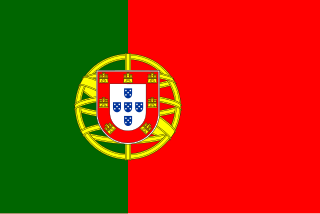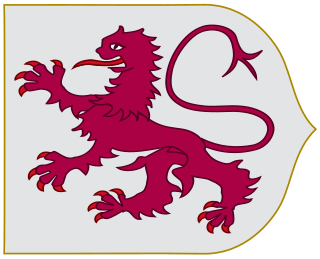 W
WAl-Andalus was the Umayyad-ruled Iberian Peninsula. The term is used by modern historians for the former Islamic states in Iberia. At its greatest geographical extent, its territory occupied most of the peninsula and a part of present-day southern France, Septimania, and for nearly a century extended its control from Fraxinet over the Alpine passes which connect Italy to Western Europe. The name more specifically describes the different Arab or Berber states that controlled these territories at various times between 711 and 1492, though the boundaries changed constantly as the Christian Reconquista progressed, eventually shrinking to the south and finally to the vassalage of the Emirate of Granada.
 W
WThe Kingdom of the Algarve, after 1471 Kingdom of the Algarves, was a nominal kingdom within the Kingdom of Portugal, located in the southernmost region of continental Portugal.
 W
WThe Kingdom of Asturias was a kingdom in the Iberian Peninsula founded in 718 by the Visigothic nobleman Pelagius. It was the first Christian political entity established after the Umayyad conquest of Visigothic Hispania in 718 or 722. That year, Pelagius defeated an Umayyad army at the Battle of Covadonga, in what is usually regarded as the beginning of the Reconquista.
 W
WThe County of Coimbra was a political entity consisting of the lands of Coimbra, Viseu, Lamego and Santa Maria da Feira, in modern Portugal. It arose within the Kingdom of Asturias following the reconquest of the region, when the lands were granted to count Hermenegildo Gutiérrez, who over the next four decades was largely responsible for the resettlement of the depopulated province. He and his immediate successors were counts, and held Coimbra, but were not explicitly Counts of Coimbra, although they are sometimes referred to as such retrospectively. The first nobleman specifically to be called Count of Coimbra was Gonzalo Muñoz, who was probably a scion of the family of Hermenegildo. Becoming Count around 959, he was one of the most powerful noblemen in the western part of the kingdom until he rose in rebellion against king Bermudo II of León and was probably killed during the region's subjugation. The degree to which his successors were alienated from their monarch can be seen when, following the region's recapture in 987 by the Moors of Al-Mansur, Gonzalo's sons joined that general in his sack of Santiago de Compostela in 997.
 W
WThe County of Portugal refers to two successive medieval counties in the region around Braga and Porto, today corresponding to littoral northern Portugal, within which the identity of the Portuguese people formed. The first county existed from the mid-ninth to the mid-eleventh centuries as a vassalage of the Kingdom of Asturias and later the Kingdoms of Galicia and León, before being abolished as a result of rebellion. A larger entity under the same name was then reestablished in the late 11th century and subsequently elevated by its count in the mid-12th century into an independent Kingdom of Portugal.
 W
WCouto Misto was an independent microstate on the border between Spain and Portugal. It was composed of the villages of Santiago de Rubiás, Rubiás, and Meaus, all in the Salas Valley, Ourense, Galicia. The territory of the Couto Misto also included a small uninhabited strip now part of the Portuguese municipality of Montalegre.
 W
WThe Ditadura Nacional was the name given to the regime that governed Portugal from 1926, after the re-election of General Óscar Carmona to the post of President, until 1933. The preceding period of military dictatorship that started after the 28 May 1926 coup d'état is known as Ditadura Militar. After adopting a new constitution in 1933, the regime changed its name to Estado Novo. The Ditadura Nacional, together with the Estado Novo, forms the historical period of the Portuguese Second Republic (1926–1974).
 W
WThe Estado Novo, or the Second Republic, was the corporatist regime installed in Portugal in 1933. It evolved from the Ditadura Nacional formed after the coup d'état of 28 May 1926 against the democratic and unstable First Republic. Together, the Ditadura Nacional and the Estado Novo are recognised as the Second Portuguese Republic. The Estado Novo, greatly inspired by conservative and autocratic ideologies, was developed by António de Oliveira Salazar, who was President of the Council of Ministers from 1932 until illness forced him out of office in 1968.
 W
WThe First Portuguese Republic spans a complex 16-year period in the history of Portugal, between the end of the period of constitutional monarchy marked by the 5 October 1910 revolution and the 28 May 1926 coup d'état. The latter movement instituted a military dictatorship known as Ditadura Nacional that would be followed by the corporatist Estado Novo regime of António de Oliveira Salazar.
 W
WThe Kingdom of Portugal was a monarchy on the Iberian Peninsula and the predecessor of the modern Portuguese Republic. It was in existence from 1139 until 1910. After 1415, it was also known as the Kingdom of Portugal and the Algarves, and between 1815 and 1822, it was known as the United Kingdom of Portugal, Brazil and the Algarves. The name is also often applied to the Portuguese Empire, the realm's extensive overseas colonies.
 W
WThe history of the Kingdom of Portugal from the Illustrious Generation of the early 15th century to the fall of the House of Aviz in the late 16th century has been named the "Portuguese golden age" and the "Portuguese Renaissance". During this period, Portugal was the first European power to begin building a colonial empire as Portuguese sailors and explorers discovered an eastern route to India as well as several Atlantic archipelagos and colonized the African coast and Brazil. They also explored the Indian Ocean and established trading routes throughout most of southern Asia, sending the first direct European maritime trade and diplomatic missions to Ming China and to Japan. The Portuguese Renaissance produced a plethora of poets, historians, critics, theologians, and moralists. The Cancioneiro Geral by Garcia de Resende is taken to mark the transition from Old Portuguese to the modern Portuguese language.
 W
WThe history of the kingdom of Portugal and the Algarves, from the First Treaty of San Ildefonso and the beginning of the reign of Queen Maria I in 1777, to the end of the Liberal Wars in 1834, spans a complex historical period in which several important political and military events led to the end of the absolutist regime and to the installation of a constitutional monarchy in the country.
 W
WThe Monarchy of the North, officially the Kingdom of Portugal, was a short-lived revolution and monarchist government that occurred in the North of Portugal, in early 1919. It was based in Porto and lasted from 19 January to 13 February 1919. The movement is also known by the derogatory term Traulitânia.
 W
WThe Kingdom of Galicia and León was an independent kingdom situated in the northwest region of the Iberian Peninsula. It was founded in AD 910 when the Christian princes of Galicia along the northern coast of the peninsula shifted their capital from Oviedo to the city of León. The kings of Galicia fought civil wars, wars against neighbouring kingdoms, and campaigns to repel invasions by both the Moors and the Vikings, all in order to protect their kingdom's changing fortunes.
 W
WThe Kingdom of the Suebi, also called the Kingdom of Gallæcia or Suebi Kingdom of Gallæcia, was a Germanic post-Roman kingdom that was one of the first to separate from the Roman Empire. Based in the former Roman provinces of Gallaecia and northern Lusitania, the de facto kingdom was established by the Suebi about 409, and during the 6th century it became a formally declared kingdom identifying with Gallaecia. It maintained its independence until 585, when it was annexed by the Visigoths, and was turned into the sixth province of the Visigothic Kingdom in Hispania.
 W
WThe Monarchy of the North, officially the Kingdom of Portugal, was a short-lived revolution and monarchist government that occurred in the North of Portugal, in early 1919. It was based in Porto and lasted from 19 January to 13 February 1919. The movement is also known by the derogatory term Traulitânia.
 W
WLusitania or Hispania Lusitana was an ancient Iberian Roman province located where modern Portugal and part of western Spain lie. It was named after the Lusitani or Lusitanian people.
 W
WThe Monarchy of the North, officially the Kingdom of Portugal, was a short-lived revolution and monarchist government that occurred in the North of Portugal, in early 1919. It was based in Porto and lasted from 19 January to 13 February 1919. The movement is also known by the derogatory term Traulitânia.
 W
WAl-Andalus was the Umayyad-ruled Iberian Peninsula. The term is used by modern historians for the former Islamic states in Iberia. At its greatest geographical extent, its territory occupied most of the peninsula and a part of present-day southern France, Septimania, and for nearly a century extended its control from Fraxinet over the Alpine passes which connect Italy to Western Europe. The name more specifically describes the different Arab or Berber states that controlled these territories at various times between 711 and 1492, though the boundaries changed constantly as the Christian Reconquista progressed, eventually shrinking to the south and finally to the vassalage of the Emirate of Granada.
 W
WThe Third Portuguese Republic is a period in the history of Portugal corresponding to the current democratic regime installed after the Carnation Revolution of 25 April 1974, that put an end to the paternal autocratic regime of Estado Novo of António de Oliveira Salazar and Marcello Caetano. It was initially characterized by constant instability and was threatened by the possibility of a civil war during the early post-revolutionary years. A new constitution was drafted, censorship was prohibited, free speech declared, political prisoners were released and major Estado Novo institutions were closed. Eventually the country granted independence to its African colonies and begun a process of democratization that led to the accession of Portugal to the EEC in 1986.
 W
WThe Visigothic Kingdom or the Kingdom of the Visigoths was a kingdom that occupied what is now southwestern France and the Iberian Peninsula from the 5th to the 8th centuries. One of the Germanic successor states to the Western Roman Empire, it was originally created by the settlement of the Visigoths under King Wallia in the province of Gallia Aquitania in southwest Gaul by the Roman government and then extended by conquest over all of Hispania. The Kingdom maintained independence from the Eastern Roman or Byzantine Empire, whose attempts to re-establish Roman authority in Hispania were only partially successful and short-lived.